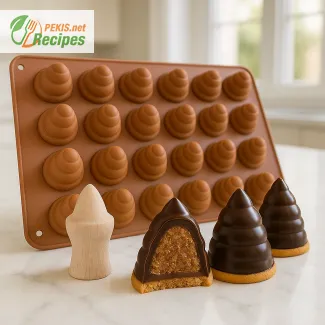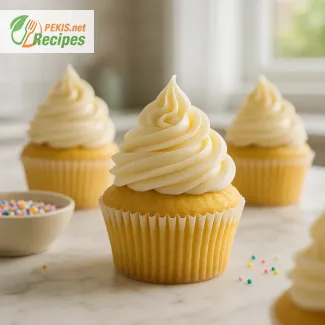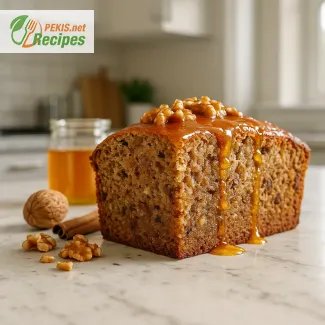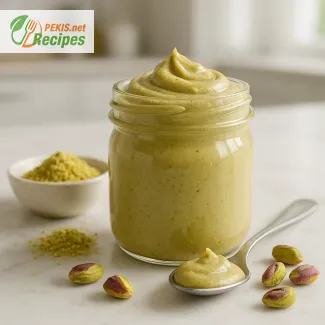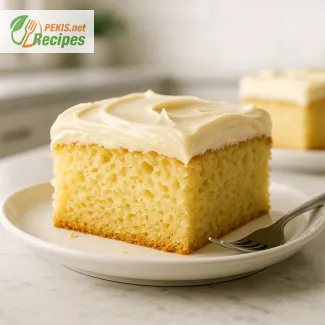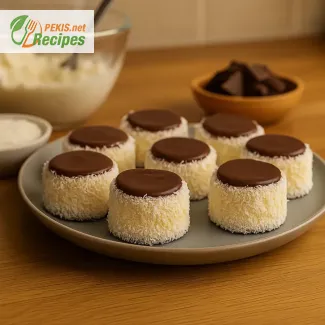
Discovering the Unique Charm of Ruske Kape: A Coconut-Chocolate Delight from the Balkans
Traditional Balkan pastries meet indulgent layers of cocoa, cream, and coconut
The Ruske Kape, or Russian Hats Cake, is one of those distinctive Balkan desserts that captivates at first glance and seduces with its rich flavors. Originating from regions like Serbia, Croatia, and Bosnia and Herzegovina, this dessert has made its way into the hearts of cake lovers across Europe. Recognizable by its dome-shaped form, dusting of shredded coconut, and elegant chocolate glaze, this treat is a perfect example of the fine balance between traditional baking and visual elegance.
Ruske Kape are traditionally served during festive occasions, family gatherings, and holidays, offering both a visually impressive presentation and a satisfyingly balanced taste profile. The name, inspired by the resemblance to Russian ushanka hats, adds a cultural touch that intrigues and delights those discovering the dessert for the first time.
What makes Ruske Kape a unique dessert experience
One of the key reasons for the rising popularity of Ruske Kape beyond its Balkan roots is its harmonious texture. The base is typically made of a soft sponge cake, layered with vanilla or butter cream, and covered in a thin chocolate ganache. Its signature edge is rolled in unsweetened coconut flakes, creating a crisp contrast to the creamy interior. This fusion of fluffy cake, rich filling, and textural coating makes each bite an engaging experience.
In the world of traditional European desserts, Ruske Kape stand out not just for their flavor but also their convenient individual portion size. These small cakes are usually cut with a round mold and assembled into miniature dome shapes, making them ideal for serving at parties or on dessert platters. Their compactness also allows for better flavor concentration and visual uniformity, both of which contribute to their growing appeal.
A closer look at the ingredients and preparation style
At the heart of every authentic Ruske Kape is simplicity and quality. The sponge base is usually made with basic pantry ingredients like eggs, sugar, flour, and baking powder, resulting in a light and airy texture. The filling varies between families and regions, with some opting for buttercream, others for a vanilla custard, or even a light whipped cream-based mixture. This layer provides the creamy softness that complements the coconut and chocolate.
The final coating—a chocolate glaze made with cocoa powder, sugar, and butter—seals the top and adds a rich, glossy finish. The sides are carefully pressed into shredded coconut, not only enhancing the flavor but also giving it that signature snow-dusted hat appearance. Occasionally, bakers will add a drop of cherry liqueur or vanilla extract into the cream layer to elevate the aroma and complexity.
Cultural significance and regional adaptations
While the origin of the name “Ruske Kape” points to Russian influence, the dessert itself is a product of Balkan ingenuity. It reflects the culinary tradition of turning simple, available ingredients into elegant and refined confections. Over time, each Balkan region has developed its own variation—some recipes add ground walnuts to the sponge base, others substitute coconut with crushed almonds or even grated chocolate flakes.
This dessert is deeply embedded in Balkan celebrations, particularly in Slava feasts, weddings, and holiday tables. Its recognizable shape and careful decoration are often a symbol of a family’s dedication to tradition and hospitality. In recent years, Ruske Kape recipes have begun circulating more widely online and in international baking circles, further fueling interest in Eastern European dessert culture.
Why Ruske Kape deserve a place in your recipe collection
For anyone passionate about layered desserts, coconut treats, or chocolate pastries, Ruske Kape is a must-try. It delivers the decadence of a multi-layered cake in the form of bite-sized elegance. With a sponge-custard-chocolate trio that hits every flavor note—sweet, creamy, rich, and lightly nutty—it’s a dessert that satisfies both the eye and the palate.
Whether you’re recreating it from nostalgic memories or trying it for the first time, Ruske Kape offer a beautifully crafted culinary journey into the heart of Balkan home baking. Its familiar yet unique ingredients make it approachable for beginners, while the layered technique and finishing touches offer enough complexity to challenge and reward experienced bakers. The result is always a plate of visually stunning, coconut-coated mini cakes that look as good as they taste.
Step 1 – Prepare the sponge cake:
Preheat the oven to 180°C (356°F). Line a baking tray (approx. 30 x 40 cm / 12 x 16 inch) with parchment paper. In a bowl, beat the eggs with the sugar until fluffy and light in color (about 5–7 minutes). Sift together the flour, cocoa powder, and baking powder, then gently fold into the egg mixture. Pour the batter evenly into the tray and bake for about 15–20 minutes. Let the sponge cool completely, then use a round cookie cutter (about 6–7 cm / 2.5 inch in diameter) to cut out circles.
Step 2 – Make the cream filling:
In a saucepan, mix the sugar and cornstarch with a small amount of cold milk to form a smooth paste. Gradually add the rest of the milk and bring the mixture to a boil over medium heat, stirring constantly until it thickens into a custard. Remove from heat and let cool slightly. Mix in the butter and vanilla extract until fully incorporated. Allow the cream to cool completely before using.
Step 3 – Assemble the cakes:
Spread a generous spoonful of the cream filling on one sponge circle and top with another circle to form a mini cake. Repeat until all sponge circles are paired. Coat the sides of each cake with the remaining cream and roll them in shredded coconut, pressing lightly to help the coconut stick. Place all coated cakes onto a rack or tray.
Step 4 – Make the chocolate glaze:
In a small saucepan, combine the cocoa powder, sugar, milk, and butter. Heat gently while stirring until everything is melted and the glaze is smooth and glossy. Remove from heat and let it cool slightly so it thickens just enough to hold on top of the cakes.
Step 5 – Finish the cakes:
Spoon the chocolate glaze over the top of each cake, letting it drip slightly down the sides. Chill the finished Ruske Kape in the refrigerator for at least 1 hour before serving to allow the glaze to set and the flavors to meld.
Enhancing Ruske Kape for Modern Palates
Tips and Variations to Refine the Classic Russian Hats Cake
Ruske Kape, with their rich chocolate sponge, creamy vanilla filling, and coconut-coated sides, offer a nostalgic experience for many who grew up with Balkan cuisine. However, even a time-honored dessert like this can be adapted to suit evolving preferences, dietary needs, and presentation styles. Whether you're baking them for a special event or exploring regional sweets at home, understanding the impact of each ingredient and preparation method can help you make this dessert even more memorable.
Flavor-enhancing ingredient substitutions
One of the easiest ways to elevate the flavor profile of Ruske Kape is to make subtle changes to the cream filling. Instead of traditional vanilla custard, try incorporating white chocolate ganache or a mascarpone-based cream, which adds richness and a silky texture. This slight shift can result in a deeper flavor that pairs beautifully with the chocolate and coconut. You can also infuse the filling with orange zest or almond extract for a delicate aromatic twist.
The sponge cake itself can also be adjusted. Swapping regular cocoa powder with Dutch-processed cocoa will yield a smoother, more intense chocolate flavor. Additionally, adding a tablespoon of strong espresso or brewed coffee into the batter won’t make the cake taste like coffee—it simply intensifies the chocolate character.
Making Ruske Kape healthier without losing indulgence
To make this dessert more suitable for health-conscious bakers, there are several nutrient-conscious adjustments that can be made without compromising texture or taste. Replace part of the all-purpose flour with whole wheat flour (up to 30%) to add fiber and a mild nuttiness. Use plant-based milk like almond or oat milk for a dairy-free alternative, and coconut oil in place of butter for a lighter fat profile.
Sweeteners can also be adapted: try using maple syrup or coconut sugar in the cream or sponge base. These offer a lower glycemic index and contribute a richer, caramel-like sweetness. For those looking to reduce sugar further, consider a blend of natural sweeteners like stevia or erythritol, keeping in mind that their potency and texture can alter the final result.
Why homemade always wins
Preparing Ruske Kape from scratch offers several advantages over store-bought or industrial versions. Freshly made cream filling has a much smoother texture and more balanced sweetness. The chocolate glaze, when made at home, retains its glossy finish and rich aroma without the use of preservatives. Additionally, using high-quality coconut flakes and real butter or cocoa allows for a more authentic taste experience.
Homemade versions also give you full control over portion size, sweetness, and presentation. You can tailor the dome shape more consistently, experiment with sizes for mini bites or larger cakes, and even choose to pipe decorative designs on top.
Common mistakes and how to avoid them
Despite its seemingly straightforward construction, Ruske Kape requires attention to detail. A few common mistakes can impact both taste and appearance:
- Overbaking the sponge: Dry sponge cakes are a frequent issue. Be sure to test for doneness at the minimum recommended baking time.
- Cream too runny: If the filling hasn’t cooled properly before spreading, it may be too soft to hold its shape. Allow it to reach full room temperature, then refrigerate briefly if needed.
- Uneven shaping: Use a metal ring cutter for precision, and always chill the assembled cakes before glazing to maintain structure.
- Glaze too hot: Pouring overly warm chocolate glaze can melt the cream layer. Let it cool slightly until it thickens but still flows.
Creative presentation and texture variations
While the classic appearance of Ruske Kape is iconic, there’s room for visual creativity. You can coat the sides with toasted coconut flakes or finely chopped roasted nuts like hazelnuts or almonds for a crunchier contrast. Instead of the standard glossy dome, try dusting the tops with cocoa powder, edible gold flakes, or grated dark chocolate for a more artisanal look.
For a layered effect, slice the sponge into thinner layers and alternate with cream to form mini multi-tiered versions. These can be placed in clear cups for individual servings, perfect for events or gifting.
Combining traditional and modern influences
What makes Ruske Kape special is its nostalgic value, but modern influences can breathe new life into it. For instance, using coconut cream as a base for the filling (instead of butter and milk) makes the dessert vegan-friendly and doubles down on the coconut flavor. Another innovation is to replace the sponge with a gluten-free almond flour base, making it accessible to those with gluten sensitivities.
You can even reinterpret the glaze with a dark chocolate ganache using cream and 70% cocoa chocolate, adding a grown-up richness and reducing sugar content. Infusing the glaze with a touch of rum or cherry liqueur also adds complexity, complementing the tropical notes of coconut and deep cocoa.
How ingredient quality defines the final result
Each element in this recipe stands on its own, but the quality of ingredients has a compounding effect. Always choose unsweetened shredded coconut with no added preservatives, and opt for real vanilla extract rather than artificial essence. When using butter, select high-fat European-style butter for its creaminess and depth.
Chocolate plays a starring role—low-quality cocoa can taste chalky or flat. Investing in premium cocoa powder or real couverture chocolate (if making a ganache) transforms the final taste and texture into something truly gourmet.
With mindful improvements and creative experimentation, Ruske Kape can evolve into a dessert that balances tradition and innovation. It remains deeply rooted in Balkan identity while offering endless room for personalization, healthier options, and contemporary flair.
Allergens present in the recipe:
- Eggs
- Gluten (wheat)
- Milk (dairy)
Suggestions to replace allergens and gluten:
- Replace wheat flour with gluten-free all-purpose flour blend with xanthan gum.
- Substitute cow’s milk with unsweetened almond milk or oat milk, and butter with vegan margarine.
- Use egg replacer powder or a mix of ground flaxseed (1 tbsp flaxseed + 3 tbsp water per egg).
Vitamins and minerals per serving (approximate):
- Vitamin B2 (Riboflavin): 0.3 mg – supports energy metabolism and cellular function
- Calcium: 85 mg – essential for bone health
- Magnesium: 35 mg – aids muscle function and energy production
- Phosphorus: 95 mg – supports bone and cell repair
- Iron: 1.2 mg – supports oxygen transport in the blood
- Zinc: 0.8 mg – contributes to immune system support
Antioxidants per serving (approximate):
- Flavonoids from cocoa: 85 mg – help reduce inflammation and support cardiovascular health
- Phenolic acids from coconut: 20 mg – contribute to antimicrobial and protective effects
- Vitamin E from butter and coconut: 0.6 mg – supports skin health and cellular protection
